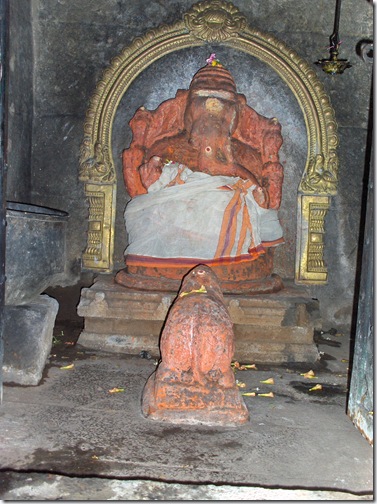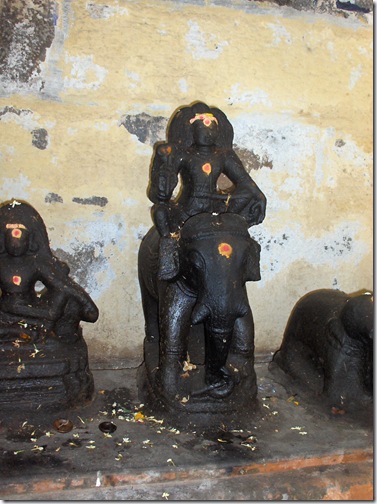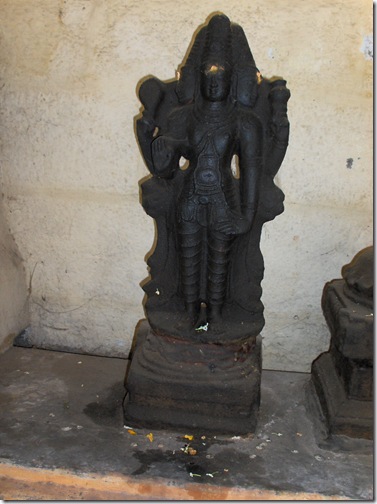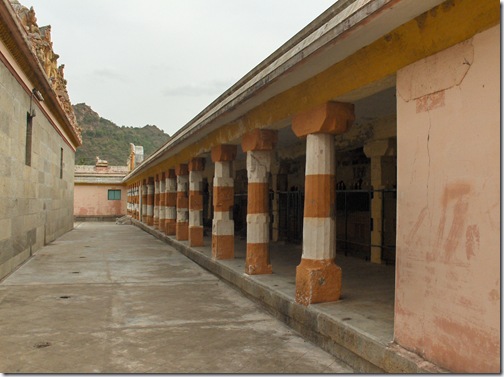Adi Annamalai Temple – North side of Arunachala: By Richard Clarke
Adi Annamalai is the oldest temple around Arunachala. It was built hundreds of years before Arunachaleswarar Temple, which per Wikipedia, “The earliest known record of the temple is in the works of the poet Nakkirar of the third Tamil Sangam period. At that time, the temple might have been a simple wooden structure. The present masonry structure and gopurams (temple towers) date back approximately 1200 years.”
Adi Annamalai clearly predates Arunachaleswarar Temple, so is older than 2000 years. I suspect the gopuram is also about 1200 years old, from the same period as Arunachaleswarar Temple.
“The name of this Temple, Adi Annamalai means ‘first’ or ‘ancient’ Annamalai (Arunachaleshwarar). Its size is small and it occupies only 1/2 acre in size – compared with the 25-26 acre size of Arunachaleswarar Temple on the Tiruvannamalai side of the Hill. The legend of Adi Annamalai recounts that Brahma, after His dispute with Vishnu about the fiery column, made a lingam and went to the other side of the Hill to worship Shiva. Thus, this lingam is supposed to be the first, ancient and original lingam of Annamalai and hence the name Adi Annamalai.” This quote is from Arunachala Grace Blog. Here is a good article from them on Adi Annamalai.
There are many legends about this temple. The one I like the best is of a secret cave that goes from the temple to inside Arunachala, where all the Siddhis are.
You can see the temple in Google maps, click here.
Turning off the Hill Round Road, going through the small village of Adi Annamalai, you come to the temple, with its tower visible from far away.
And enter through the gopuram.
If you look closely at the gopuram, you will see images that illustrate many ancient stories of the gods. A repeated figure is that of a man, straining to hold up the tower. Since the wall has its own support all this effort is not needed. This image is to illustrate the futility of ego-driven action, ‘trying to hold up the universe’ when it is really God, Siva, Brahman, your Self, that is doing ‘all the work.’
We are not allowed to take photos inside the main shrine. The photos below were taken walking around within the temple walls.
First is Ganesh, the remover of obstacles. This is the first god seen in the Siva temples. Here Ganesh is enclosed in a small shrine that is locked when the priest is not there.
Walking in the usual clockwise direction, here is a hall of pillars. Note all the statues on top of the wall. Similar statues are on all four sides of the temple.
Here is a close up of one on this wall:
Looking to the back of the temple, we can see the Dakshinamurthy shrine protruding from the wall.
Here is Dakshinamurthy, the Southward-facing god. From the Wikipedia entry, “Dakshinamurti literally means ‘one who is facing south (dak?i?a)’ in Sanskrit. South is the direction of Death, hence change. In every Siva temple the stone image of Dakshinamurthy is installed, facing south, on the southern circumambulatory path around the sanctum sanctorum.”
Dakshinamurthy has a special place in our hearts. Dakshinamurthy is said to be the primordial Guru. He is pictured as a young man, with four older disciples sitting with him. Dakshinamurthy taught only in silence. Sri Ramana Maharshi is spoken of comparing him to Dakshinamurthy. It is also said that Arunachala is Dakshinamurthy. Certainly both teach in silence. Ramana says that real silence is when no ego-‘I’ arises.

Looking back from Dakshinamurthy, one can see Arunachala. Here is the face of ‘The Elephant.’ I wrote an entry about Arunachala in this area, see
.Behind the shrine, behind the pillars on the back wall of the temple, there are quite a number of statues, I think of various local gods, and gods of local significance. You can see, looking at the wear on some of these, just how ancient they must be, hundreds of years, certainly, thousands of years, probably.
Most of them I do not recognize. They have names, written in an archaic Tamil, above each statue. As I find out these names, I will add them to this post. Some are small, just a few inches tall. Others are several feel high.
Here is one of three Nandis, guarding several ancient lingams behind the fence.
Here are the first two lingams.
Here is the third. Note the additional carving on the upper part. Someone thought this was special. It is the only one that has a flower placed on top of it.
Here is the fourth. Notice that it has a face, surely Siva’s face, carved into it.
I love this one. Is that Siva on the elephant?
Notice how old this elephant must be. The top of the statue has been rubbed away by countless hands touching it, probably over hundreds of years.
Looking back at the hall of statues.
We walk back toward the front of the Temple.
Another statue. This god has three faces (that I can see).
The gopuram, seen from within the temple walls.
The main entryway, from the North side. To the right is the inner temple. To the left, back outside.





































Is Siddha Idaikkadar jeeva samadhi in the this temple?
Mahendran G.C
LikeLike
Your observations are revealing. The clarity in descriptions is simply fine.
LikeLike
Awesome photographs. Thank you so much. Tamil is my native language. I can read the deities name written in Tamil. Let me know, if you wish to add them to the article.
LikeLike
Pingback: Two temples (1/2) Thiruvannamalai – Aalochanai